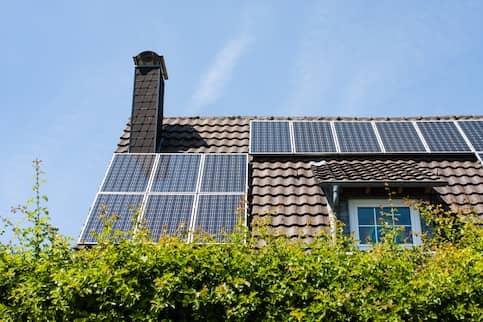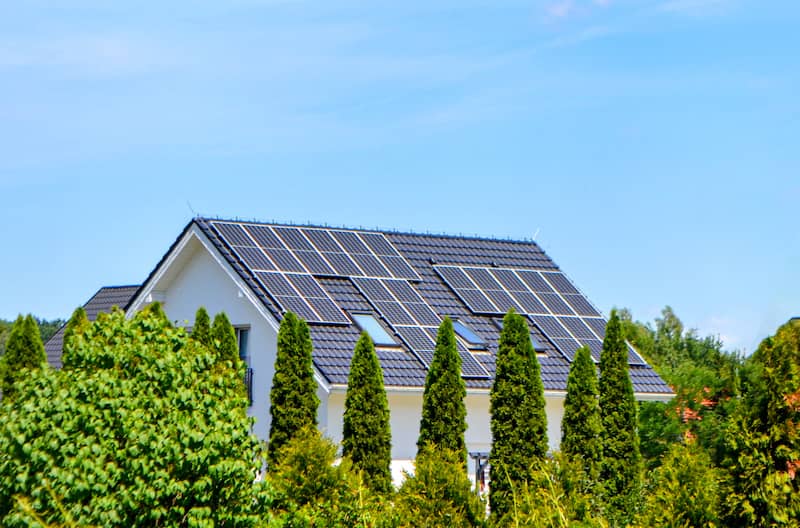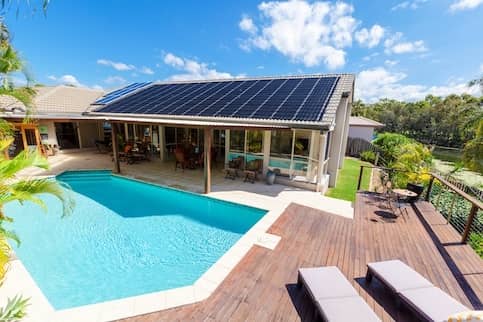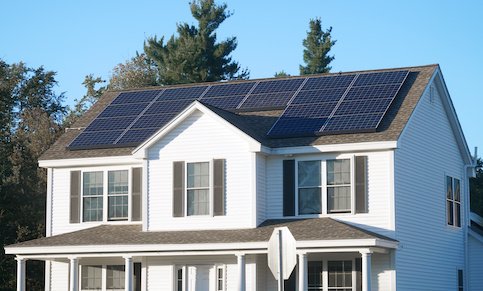The sun, in 1 hour, sends more energy to Earth than the world consumes in a year. We can harness this energy with solar panels, an alternative, more sustainable method to the continued use of fossil fuels. Whether you’re buying a house with solar panels or are considering adding solar energy to your home, it’s important to understand the following basics of a home solar system.
Solar Power: A Quick Overview
Solar power is the most abundant form of energy on earth and one of the most environmentally friendly energy alternatives. In the United States, the demand for solar power is at an all-time high and its capacity has grown from 1.2 gigawatts (GW) in 2008 to 121 GW in 2021. That is enough to power 23.3 million homes!
Solar panels are also durable and can last up to 25 years, making solar power a sustainable, long-term, low risk investment that can lower your utility bills and increase the value of your home.
See What You Qualify For
Buy A Home
Discover mortgage options that fit your unique financial needs.

Refinance
Refinance your mortgage to have more money for what matters.
Tap Into Equity
Use your home’s equity and unlock cash to achieve your goals.
How Does A Solar Panel Work?
Solar panels are made up of small units called photovoltaic cells (PV) or solar cells. Within each one of these cells are atoms bonded together by electrons. Solar power is generated when rays of light from the sun, which carry positively charged particles called photons, hit the panel with enough force to knock an electron out of its bond. When these electrons get knocked loose, they leave “holes” in the cell where the negatively charged electron used to be.
Once they get knocked out, the electrons move through a circuit, where they leave from one end of the cell, move through a conductor, and then enter on the other side of the cell where they can fill the hole they left. This movement of electrons out of the cell, through the conductor and back to their hole is an electric current that generates electricity.
Understanding A Home Solar System
Aside from the solar panels themselves, there are numerous other aspects of a home solar system that contribute to its effectiveness. First, there are inverters which allow energy generated from the solar panels to be used by the home. Then there is the performance-monitoring system that gives you data on how well your solar system is working. In addition to these tools, you can also add batteries to your system, to become even more energy independent. Finally, there is the mounting hardware, which provides the base for your home solar system.
Solar Panels Collect Light And Create Current
As we know, solar panels collect rays of sunlight which generates electricity. Electricity comes in two forms: direct current (DC) and alternating current (AC). These terms refer to the way electricity flows in these two systems. In a DC system, current flows in one direction. However, in an AC system, electrons switch directions, moving forward and backwards through the circuit.
Solar systems and batteries use and produce DC electricity while most homes and their appliances use AC electricity. So, the question becomes, how can we use solar energy to power a home if the currents aren’t compatible?
Inverters Convert DC Power To Usable AC Power
We use solar energy to power homes by converting DC power from the solar panels to usable AC power with tools called inverters.
Solar inverters can quickly and rapidly reverse the direction the electrons flow — to alternate the current — so it can power your home. Essentially, inverters switch the way the current flows in a solar cell, so the direct current from solar cells is compatible with the alternating current that your home needs. Inverters tend to last roughly 10-15 years and there are two main types, each of which has its own advantages and disadvantages.
- String/central inverter: String inverters, also known as central inverters, alternate the current from multiple panels at once, meaning that most residential solar systems need between 1 and 2. Since you don’t need many of these inverters, it can lower the cost, but the fact that the panels are all connected can make it hard to troubleshoot problems with specific panels.
- Microinverters: Microinverters manage the current of a single solar panel in the system. So, if your system has 20 panels, you need 20 microinverters. These inverters are great for homes that have irregular shapes or receive varying sunlight but buying an inverter for every solar panel in your system can add up quickly.
Performance-Monitoring Systems Provide Production Data
Performance-monitoring systems give you real-time and historic energy production data from your home solar system. This information can help you find maintenance issues, especially if some panels aren’t producing as much power as others. It’s common for your performance monitoring system to come from your inverter manufacturer, so depending on the type of inverter you use, you’ll be able to see different problems more easily.
Batteries Offer Even More Energy Independence
Most solar systems don’t come with batteries, but they are becoming more popular due to their benefits. Batteries store extra power that you’ve accumulated during the day, which you can use later when the sun isn’t accessible.
Batteries are especially necessary for off-grid homes, homes not connected to the electrical grid. However, batteries can also be beneficial for homes that are tied to the electrical grid. Batteries can help homeowners avoid some of the fees associated with using electricity during peak hours and can also provide electricity during power outages.
If you decide that you want a battery for your home solar system, you may also need an inverter for your battery, since the electricity it stores will be in the form of DC current and most houses require AC current.
Mounting Hardware Provides The Base For Solar Arrays
Mounting hardware is what holds solar panels in place. Even though it’s usually not seen, it’s a critical component and can change the look of the solar system.
Solar panel installers will determine the best place to install mounting hardware, either at the same angle as the roof or at a different angle depending on where the panel can get the most sunlight. Installers will drill holes into the rafters, secure the mount with steel bolts, and seal the surrounding area. Then they’ll fasten the solar panel to the mount and connect it to the electrical supply.
How Do Solar Panels Work On A House?
Your solar panels will generate most of their energy during the day when the sun is in the sky and, most likely, no one is home. What your solar system does with that energy is dependent on the extent to which the solar panel is tied to the electrical grid. Homes with a solar system can be classified as grid-tied, hybrid or off-grid, but all three use solar panels slightly differently.
Grid-Tied
Most solar-powered homes are grid-tied, meaning that they’re able to access the electrical grid on cloudy days or at night when the panels don’t get as much sun. Homeowners with grid-tied systems still get electrical bills, but they’re usually much lower. This is because some homeowners spend less on electricity through something called “net metering.” Net metering is a billing technique where homeowners can sell unused electricity generated by the solar system back to the electrical grid. It’s a way for utility companies to pay homeowners for using solar energy and store that energy within the electrical grid. The homeowner can then pull energy from the grid when they aren’t generating enough to power their home.
Basically, grid-tied homes generate solar power during the day that tends to go unused by the home, so it is sold back to the electrical grid and stored there. When homeowners need electricity later in the day, they can pull it from the grid, and they’re charged for what they used minus what they gave to the grid.
Net-zero energy homes are grid-tied homes that produce enough energy to offset their energy usage through their on-site sources such as solar panels. They are designed to minimize energy usage. With this type of design, you would incur no annual energy bill and may even earn energy credits to use in the future.
Net metering laws and compensation can vary by state and utility company so be sure to check your local utility company’s policy.
Hybrid
Some homeowners opt for a hybrid system. This type of system is still grid-tied, but also possesses a battery. In a hybrid system, excess energy generated during the day is stored in a battery where homes can draw from it later. Hybrid homes are also grid-tied so there is an energy backup for when access to the sun isn’t available, your battery has run out or you can’t meet your energy demands.
Hybrid systems can also participate in net metering and having a battery can help many homeowners avoid fees from using electricity at peak hours, since they can draw from their battery instead of the electrical grid.
Off-Grid
Finally, other homeowners choose to completely forego the power grid and just use solar energy to power their home. In rural areas, the cost of extending the power grid to your home can be high, which is why many choose to live off-grid.
An off-grid solar system relies largely on batteries to power the home, as you need battery storage to support you when the sun isn’t available. The effectiveness of an off-grid system can also depend on where you live, since some places might not get enough sunlight to power their home year-round, while others receive more than enough.
The Bottom Line
Solar panels work by using the energy of the sun to generate electricity that can power your home. They can provide long-term savings by lowering your electric bills and they can reduce your carbon footprint by limiting your use of fossil fuels.
It’s important to note that solar panels aren’t ideal for all homes. If you live in a place with lots of shade or cloudy days, they may not be the best fit for you. But, if you live in a place with lots of sun year round and are considering investing in a sustainable, long-term energy alternative, learn how you can save with solar panels today.

Anna Wolski
Anna Wolski is a freelance writer. She received a bachelor's degree in psychology and English from the University of Michigan. In her free time, she enjoys reading and creative writing.












